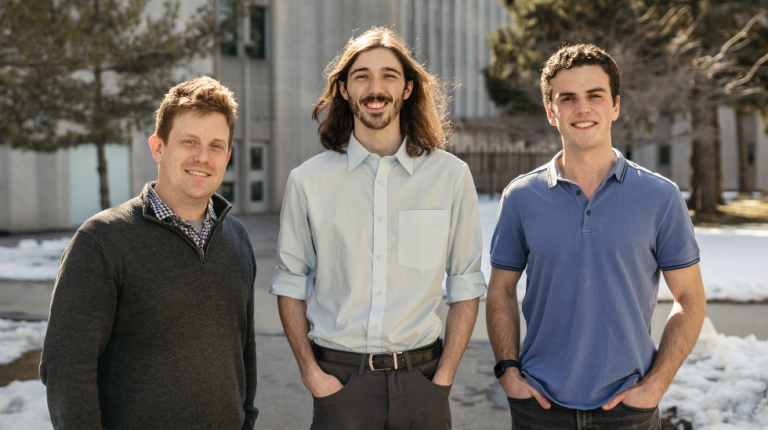McMaster Engineering Professor Andrew Gadsden and his team built the Autonomous, Robotic Telescope Mount (ARTEMIS) to provide more accurate measurements of reflected moonlight. The mount is built to withstand harsh conditions, such as extreme cold and high altitudes. ARTEMIS was flown on over 10 high-altitude flights and was effective in stable conditions, but its accuracy fluctuated during turbulence. Gadsden’s team is currently working on the second-generation High-Altitude Aircraft Mounted Robotic (HAAMR) telescope mount to improve its tracking response during turbulence. The HAAMR telescope mount will be delivered to the United States National Institute of Standards and Technology (NIST) in Gaithersburg, Maryland in July for integration with their telescope. The data collected by integrated mount will help calibrate Earth-observing satellites and provide more accurate data about Earth’s conditions and climate. The air-LUSI project, with which HAAMR will be deployed, has the potential to create stronger climate change models based on more precise measurements, which is of significant interest to European, American, and Canadian space agencies. With better data, there’s the potential to apply machine learning to predict what’s happening with our planet, study our planet’s health, protect biodiversity, and consequently, human health.
McMaster Engineering Professor Andrew Gadsden and his team have collaborated with NASA to develop an autonomous, robotic telescope mount that will enhance the accuracy of climate change models. The mount, called ARTEMIS (short for Autonomous, Robotic Telescope Mount Instrument Subsystem), was specifically designed to stabilize a telescope that will measure reflected moonlight from high-altitude flight. This mission, called the airborne lunar spectral irradiance mission or air-LUSI, will provide NASA with precise measurements of the Moon’s reflected light, which will help calibrate Earth-observing satellites. The calibration will help ensure that the data collected from these satellites is exceedingly accurate and precise.
The data collected by Earth-observing satellites is affected by the atmosphere, local conditions, and climate. By using the Moon’s light as a benchmark, NASA can obtain measurements that are unaffected by these factors, which will help them better understand what is happening on Earth. The resulting knowledge will be used to build more accurate climate change models. Gadsden notes that this project is a combination of science and engineering, as his team is providing the engineering tools to collect data, while NASA scientists analyze the data to understand its implications and initiate change.
To ensure that the measurements collected are precise, the mount must withstand high altitudes, extreme cold, and constant motion. Gadsden’s team has built the first-generation robotic mount, ARTEMIS, which will integrate with NASA’s air-LUSI telescope. The measurements collected from the integrated mount will be used by the United States National Institute of Standards and Technology and United States Geological Survey to help develop models that fine-tune NASA’s Earth-observing satellites.
In conclusion, the collaboration between McMaster and NASA has resulted in the development of a robotic telescope mount that will provide precise measurements of the Moon’s reflected light. These measurements will help calibrate Earth-observing satellites, providing more accurate data about our planet’s conditions and climate. The resulting data will be used to build better climate change models, furthering our understanding of the impact of climate change and how we can mitigate its effects.
McMaster Engineering Professor Andrew Gadsden and his team have built an autonomous, robotic telescope mount, named ARTEMIS, to stabilize a telescope that will measure reflected moonlight during high-altitude flight. The mount needs to withstand the harsh conditions of high altitudes and extreme cold, as the telescope will be flying at an altitude of approximately 70,000 feet and will be operating within the wingpod of an old Soviet-era spy plane. The design, analysis, rapid prototyping, and fabrication of this unique mount were all done in-house at McMaster because it required custom engineering components.
The ARTEMIS mount has been flown on over 10 high-altitude flights to test its functionality and reliability, and it was found to be highly effective in stable conditions. However, its accuracy fluctuated when the plane encountered turbulence, creating corrupted or uncertain measurements. One of the issues is that the telescope came in at a heavier weight than the actuators were designed to account for. Hence, Gadsden’s team is currently working on a second-generation instrument, called the High-Altitude Aircraft Mounted Robotic (HAAMR) telescope mount, to address several performance issues related to movement and improve its tracking response during turbulence.
The new design will double the tracking accuracy and maintain target lock during bumpy portions of flights. It will be delivered to the United States National Institute of Standards and Technology (NIST) in Gaithersburg, Maryland in July for integration with their telescope. The integrated mount will collect measurements that will help calibrate Earth-observing satellites, providing more accurate data about our planet’s conditions and climate.
The ARTEMIS mount is a unique engineering tool that is necessary to collect accurate data from high-altitude flights. The team’s custom work on this mount streamlines the development and provides confidence that it will work. The HAAMR telescope mount will improve the accuracy of the measurements and maintain target lock during turbulence, ensuring that the data collected is precise. The project is a combination of science and engineering, as Gadsden’s team provides the engineering tools to collect data, while NASA scientists analyze the data to understand its implications and initiate change.
In conclusion, McMaster and NASA’s collaboration has resulted in the development of a robotic telescope mount that will provide precise measurements of the Moon’s reflected light. The mount needs to withstand harsh conditions during high-altitude flight, and its custom design requires in-house engineering components. The HAAMR telescope mount will improve the accuracy of measurements and maintain target lock during turbulence. The resulting data will be used to build better climate change models, furthering our understanding of the impact of climate change and how we can mitigate its effects.
In January, the High-Altitude Aircraft Mounted Robotic (HAAMR) telescope mount will be deployed to NASA’s Neil A. Armstrong Flight Research Center in Palmdale, California, for an extended air-LUSI Operational Flight Campaign. The air-LUSI project has the potential to create much stronger climate change models based on more precise measurements. This calibration model is of significant interest to European, American, and Canadian space agencies. With better data, there’s the potential to apply machine learning to predict what’s happening with our planet. The information collected from the satellites will be used to better study our planet’s health to protect biodiversity and, consequently, human health.
Don’t miss interesting posts on Famousbio










